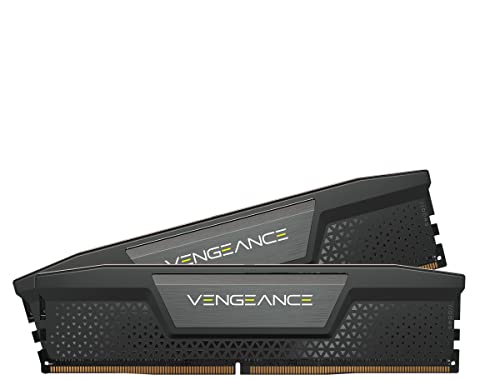If you’re looking to upgrade your desktop’s memory, you’ve likely come across the Corsair Vengeance DDR5 series. Corsair has been a long-time player in the memory market, and their latest DDR5 offerings promise to deliver even better performance than previous generations. In this comparison article, we’ll take a look at the differences between the Corsair Vengeance DDR5 5600 and 6000 models, and help you decide which one is right for you.
Quick Comparison Table
Last update on 2025-12-19 at 17:15 / Paid links / Images from Amazon Product Advertising API
| Feature | Corsair Vengeance DDR5 5600 | Corsair Vengeance DDR5 6000 |
|---|---|---|
| Brand | Corsair | Corsair |
| Computer Memory Size | 16 GB | 32 GB |
| RAM Memory Technology | DDR5 | DDR5 |
| Memory Speed | 5600 MHz | 6000 MHz |
| Compatible Devices | Desktop | Desktop |
| Voltage | 1.25 Volts | N/A |
| Form Factor | DIMM | Compact |
| Color | Black | Black |
| Model Name | Vengeance | N/A |
| Data Transfer Rate | 12 Gigabits Per Second | 6000 MHz |
| Onboard Voltage Regulation | Yes (through CORSAIR iCUE software) | Yes (through CORSAIR iCUE software) |
| Custom XMP Profiles | Yes (through CORSAIR iCUE software) | Yes (through CORSAIR iCUE software) |
| Powerful CORSAIR iCUE Software | Yes (real-time frequency readings, onboard voltage regulation, custom XMP profiles) | Yes (real-time frequency readings, onboard voltage regulation, custom XMP profiles) |
| Compact Form-Factor | No | Yes |
| Hand-Sorted, Tightly-Screened Memory Chips | Yes | N/A |
| Solid Aluminum Heatspreader | Yes | Yes |
| Optimized for Intel DDR5 Motherboards | Yes | N/A |
Speed
One of the main differences between the Corsair Vengeance DDR5 5600 and 6000 models is their memory speed. The DDR5 5600 runs at 5600 MHz, while the DDR5 6000 runs at 6000 MHz. This may not seem like a huge difference on paper, but it can translate to significant performance gains in real-world usage. If you’re someone who regularly uses resource-intensive programs or plays games that require a lot of memory bandwidth, the DDR5 6000 may be the better choice for you.
Compatibility
Both the DDR5 5600 and 6000 models are designed for desktop use and are compatible with the latest DDR5 motherboards. However, the DDR5 5600 has a larger form factor (DIMM) compared to the DDR5 6000’s compact form factor. This means that the DDR5 5600 may not fit in all desktop builds, especially those with limited space. On the other hand, the DDR5 6000’s compact form factor ensures compatibility with a wider range of desktop builds.
Voltage Regulation
Both the DDR5 5600 and 6000 models feature onboard voltage regulation, which makes overclocking easier and more stable than previous generations. This is thanks to Corsair’s iCUE software, which enables real-time frequency readings, custom XMP profiles, and onboard voltage regulation. However, the DDR5 6000 may have a slight edge in voltage regulation, as it has been optimized for Intel CPUs.
Memory Chips
Corsair hand-sorts and tightly screens their memory chips to ensure consistent high-frequency performance with aggressive timing options. Both the DDR5 5600 and 6000 models feature this technology, which ensures reliable and stable performance under heavy usage. However, the DDR5 6000 may have an advantage in this area, as it is optimized for Intel CPUs.
Heat Spreader
Both the DDR5 5600 and 6000 models feature a solid aluminum heat spreader, which conducts heat away from your memory quickly. The heat spreader also has a refined Vengeance styling to fit the look of modern systems. There is no discernible difference between the two models in this regard.
Custom XMP Profiles
Both the DDR5 5600 and 6000 models feature custom XMP 3.0 profiles, which can be customized and saved via Corsair’s iCUE software. This allows you to tailor performance by app or task for greater efficiency. There is no discernible difference between the two models in this regard.
Price
As expected, the DDR5 6000 is more expensive than the DDR5 5600. If you’re on a budget, the DDR5 5600 may be the better choice for you. However, if you’re looking for the best possible performance, the DDR5 6000 may be worth the extra investment.
Final Thoughts
Both the Corsair Vengeance DDR5 5600 and 6000 offer exceptional performance and reliability to cater to the needs of any high-end system. However, there are some key differences to consider when choosing between the two.
If you are looking for high-frequency performance and faster data transfer rates, then the Corsair Vengeance DDR5 6000 may be the ideal choice. Its onboard voltage regulation, custom XMP profiles, solid aluminum heatspreader, and compact form-factor provide excellent performance and stability, making it an ideal fit for the latest desktop motherboards.
On the other hand, the Corsair Vengeance DDR5 5600 also offers excellent performance with its hand-sorted, tightly-screened memory chips, optimized for Intel DDR5 motherboards, and powerful Corsair iCUE software. Its compact form-factor, low clearance, and aggressive timing options make it a great choice for those looking for superior overclocking ability and compatibility with nearly any DDR5 build.
Finally, the choice between Corsair Vengeance DDR5 5600 vs 6000 depends on your system needs, budget, and personal preferences. Both memory kits offer top-of-the-line performance, so no matter which one you choose, you can rest assured that you’ll have a high-performing system that can handle even the most demanding tasks with ease.

